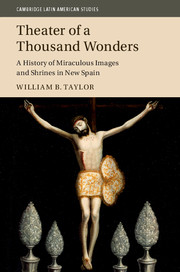Book contents
- Frontmatter
- Dedication
- Contents
- List of Figures
- List of Maps
- List of Tables
- Preface and Acknowledgments
- Archive Abbreviations
- Introduction
- Part I Bearings: Historical Patterns and Places of Image Shrines
- Part II Soundings: Divine Presence, Place, and the Power of Things
- 5 Making Miracles
- 6 Relics, Images, and Other Numinous Things
- 7 Religious Prints and Their Uses
- 8 Placing the Cross in Colonial Mexico
- 9 Pilgrims, Processions, and Romerías
- Conclusion
- Appendix 1 Colonial Image Shrines
- Appendix 2 When Shrines Began
- Appendix 3 Other Saints
- Index
7 - Religious Prints and Their Uses
from Part II - Soundings: Divine Presence, Place, and the Power of Things
Published online by Cambridge University Press: 05 September 2016
- Frontmatter
- Dedication
- Contents
- List of Figures
- List of Maps
- List of Tables
- Preface and Acknowledgments
- Archive Abbreviations
- Introduction
- Part I Bearings: Historical Patterns and Places of Image Shrines
- Part II Soundings: Divine Presence, Place, and the Power of Things
- 5 Making Miracles
- 6 Relics, Images, and Other Numinous Things
- 7 Religious Prints and Their Uses
- 8 Placing the Cross in Colonial Mexico
- 9 Pilgrims, Processions, and Romerías
- Conclusion
- Appendix 1 Colonial Image Shrines
- Appendix 2 When Shrines Began
- Appendix 3 Other Saints
- Index
Summary
Material culture presents a paradox. As John Glassie writes, it is “culture made material,” yet “culture is immaterial. Culture is pattern in mind, inward, invisible and shifting.” Material remains usually amount to scraps and tracks, or objects largely separated from their earlier contexts, their significance inferred more than established. Emily Dickinson recognized the problem in her untitled poem #344:
This was the Town she passed
There where she rested last
Then stepped more fast
The little tracks close prest
Then not so swift
Slow, slow as feet did weary grow
Then stopped, no other track!
Wait! Look! Her little Book
The leaf at love turned back
Her very Hat
And this worn shoe just fits the track
Here though fled.
“Here though fled” is the story of most vernacular objects historians come across. It remains a problem for the study of early modern Catholic Europe and America even though recent art historians, anthropologists, and historians have applied their talents to the study of various religious images as material culture and self-definition. Sensuous religious practices in Catholic Christianity make the connections between images and devotion especially compelling, but insights into their production, promotion, and regulation have been easier to come by than understanding their audience and reception. There is no easy resolution of Glassie's paradox. In a 1989 book that turned European art history decisively toward the power of all kinds of images – how they were received and used, as well as made and promoted – and challenged the idea of a sea change in the sixteenth century from cult images to the cult of art, David Freedberg declared that “the history of art is subsumed by the history of images,” by the relationships between images and people in history. Freedberg called attention to images usually overlooked by art historians – especially shrine images and things associated with them that devotees took to be a living embodiment of what they represented and where they came from. But his inquiry into “the efficacy of pictures” slighted actual responses to and uses of those images in their places and times in favor of psychological theories about response.
- Type
- Chapter
- Information
- Theater of a Thousand WondersA History of Miraculous Images and Shrines in New Spain, pp. 398 - 453Publisher: Cambridge University PressPrint publication year: 2016



